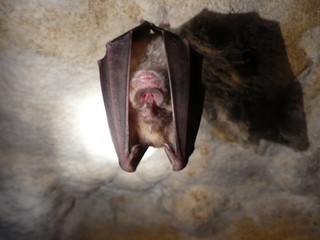
Greater horseshoe bat
Order : Chiroptera
Family : Rhinolophidae
Subfamily : Rhinolophinae
Species : Rhinolophus ferrumequinum
The Greater horseshoe bat is listed as Near Threatened (LR/nt), is close to qualifying for or is likely to qualify for a threatened category in the near future, on the IUCN Red List of Threatened Species
Namings for the greater horseshoe bat
A young / baby of a greater horseshoe bat is called a 'pup'. A greater horseshoe bat group is called a 'colony or cloud'.Countries
Afghanistan, Algeria, Armenia, Austria, Azerbaijan, Belgium, Bosnia and Herzegovina, Bulgaria, China, Croatia, Cyprus, Czech Republic, France, Georgia, Germany, Greece, Hungary, India, Iran, Iraq, Israel, Italy, Japan, Jordan, Kazakhstan, Korea, North, Korea, South, Kyrgyzstan, Lebanon, Liechtenstein, Luxembourg, Macedonia, Moldova, Morocco, Nepal, Pakistan, Poland, Portugal, Romania, Russia, San Marino, Saudi Arabia, Serbia and Montenegro, Slovakia, Slovenia, Spain, Switzerland, Syria, Tajikistan, Tunisia, Turkey, Turkmenistan, Ukraine, United Kingdom and UzbekistanSome facts about the
Greater horseshoe bat
Adult weight : 0.023 kg (0.0506 lbs)
Maximum longevity : 31 years
Female maturity :730 days
Male maturity : 730 days
Gestation : 80 days
Weaning : 60 days
Litter size : 1
Interval between litters : 365 days
Weight at birth : 0.006 kg (0.0132 lbs)
Facts about the greater horseshoe bat
"The Greater Horseshoe bat is one of the rarest bats in Britain and the population concentrations are in the South West," explained bat specialist Chris Shaw.
A female greater horseshoe bat is not sexually mature until 3-4 years of age and the male at 2-3 years of age.
Britain's population of some 5,000 greater horseshoe bats (Rhinolophus ferrumequinum) is restricted to south Wales and south-west England, although individual bats are still recorded as far away as Surrey and Leicestershire.
Female greater horseshoe bats are not usually sexually mature until their third year and one female did not breed until its tenth year.
Greater Horseshoe bats are dependant on reliable sources of insects.
Greater horseshoe bats are listed as Lower Risk by the 2000 IUCN Red List.
Status & distribution:Greater horseshoe bats are very rare and endangered.
The directivity of the nostrils of the Rhinolophus ferrumequinum is much more similar to the pattern of a transducer of 4 mm radius than of the one of 13 mm which is implemented in RoBat.
The greater horseshoe bat (Rhinolophus ferrumequinum) is found in France and Bulgaria and most southern European countries.
The greater horseshoe bat is the subject of an EN Species Recovery Programme, concentrating on feeding requirements.
Rhinolophus ferrumequinum is declining rapidly due to habitat pressures including disturbance, vandalism and practices resulting in a loss of large prey insects. (Full text)
" Nocturnal greater horseshoe bats are one of Britain's largest species of bat with a wingspan of around 36cm and weighing up to 28g. (Full text)
A new NISC species, rfbat (Rhinolophus ferrumequinum), is now available. (Full text)
back to topDescription The greater horseshoe bat is the larger of the two horseshoe bats found in Britain. (Full text)
Description The greater horseshoe bat is the larger of the two horseshoe bats found in Britain. (Full text)
Greater horseshoe bats are among the rarest in Britain, with a total population of only four to five thousand. (Full text)
The greater horseshoe bat is one of Britain's rarest bats, with a total population pf perhaps only 4,000 individuals. (Full text)
The greater horseshoe, Rhinolophus ferrumequinum, is one of the most endangered bats in Europe and is known to breed in only 13 places in Britain. (Full text)
The greater horseshoe bat Rhinolophus ferrumequinum is one of the largest bats in the UK. (Full text)
The vaginal plug of the Japanese greater horseshoe bat is composed of an outer, thick, hard and homogeneous layer originating from the stratum disjunctum of the vaginal mucosa and a thin, soft and opaque central core containing accidentally trapped dead spermatozoa. (Full text)
The greater horseshoe, Rhinolophus ferrumequinum, is one of the most endangered bats in Europe. (Full text)
More animals beginning with G
